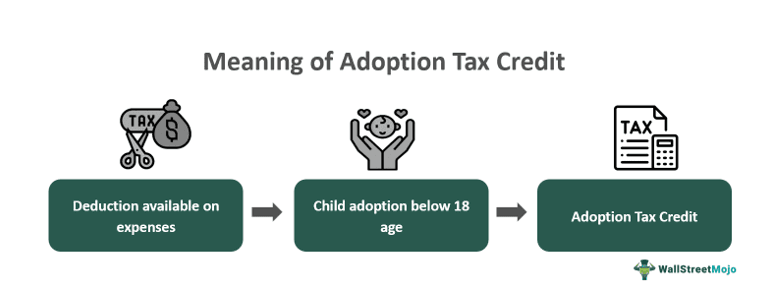Table of Contents
What Is The Adoption Tax Credit?
Adoption tax credit refers to the reduction or exemption obtained on child adoptions, either domestically or internationally. It directs whether a person is eligible to receive a credit for the expenses incurred in adopting a child. The amount available changes annually.

The federal adoption tax credit came into force in 1981, but only for special needs adoption. At that time, the credit amount on child adoption was $1500. However, it was tax deductible for the amount spent on the adoption. Since then, there have been various amendments to the regulation.
Key Takeaways
- Adoption tax credit is a deduction available for taxpayers when adopting a child. The child must be below the age of 18 or require special care.
- There are specific fees qualified for credit, like attorney fees, court fees, adoption-related expenses, traveling fares, meals, plane tickets, and medical expenses.
- In 2023, the MAGI was set at $279,230 per year. However, it is subjective to change every year.
- The child can also be a resident alien who is a foreign child but resides in the US.
How Does Adoption Tax Credit Work?
Adoption tax credit is a federal regulation that allows citizens to avail of a deduction on the expenses incurred during the child's adoption. It is a part of the US tax code for normal and special needs adoptions. However, it is deductible only for adoption-related expenses, which include:
- Reasonable and vital expenses related to adoption needs
- Court costs and attorney fees
- Medical exams and physical tests expenses
- Traveling expenses (amounts spent for meals, plane tickets, lodging while away from home), gas expenses
- Other expenses that are directly related to and for the primary purpose of the legal adoption of an eligible child.
However, there are certain complications to qualified expenses. For instance, any expense made before identifying the adopted child is also a qualified expense as per the federal adoption tax credit form. Also, the adopted child must be under the age of 18 or someone incapable physically or mentally of performing self-care. Furthermore, taxpayers cannot include expenses for the child adopted from a spouse (for example, a stepchild).
Likewise, adoption tax credits for special needs are pretty popular. When a child has some special need and cannot be adopted unless assistance is provided to the adoptive family, they qualify for this credit for special needs. However, it is necessary to submit the Subsidy Agreement to avail of this credit.
Who Qualifies For It?
Not everyone qualifies for this credit. Certain qualifications are necessary to obtain an IRS adoption tax credit. Here are the criteria:
- The child (planning to get adopted) must be a US citizen or resident alien (a foreign-born child living in the United States).
- The modified adjusted gross income (MAGI) of the adopter (taxpayer) must be under $279,230 per year. If it exceeds this amount, they cannot apply for the adoption credit.
- The adopted child must be under the age of 18. Adult adoptions do not qualify for this credit.
- In the case of domestic adoption, expenses incurred until the final adoption are eligible for deduction. However, for international adoption, expenses are deductible in the year when the adoption is finalized. If the overseas adoption is never approved, any money paid is ineligible.
Examples
Let us look at some examples to understand how they work in the federal states:
Example #1
Suppose James wishes to adopt Carol from his friend's NGO. They found her on the streets in an unhealthy condition. So, James decided to cover her expenses until her condition improved. After seven months, he was able to adopt Carol officially legally. Meanwhile, he also paid $300 as attorney and adoption fees. In total, his expenses amounted to $15,950.
However, at the time of the tax payment, James learned that he could avail of adoption credit as well. He calculated all the expenses and applied for Form 8839. At that time, his employer gave him a deduction of $5950. Furthermore, as per the IRS adoption tax credit form, he could access a deduction of $10,000.
Example #2
According to a news update as of April 2024, the families who adopted on or after June 2022 are eligible for adoption tax credit. The Montana credit adoption policy allows an amount of $5000 for adoption through private organizations. Likewise, any adoption by the state foster care system increases to $7500. However, it is essential to note that both are one-time credits and cannot be availed twice or more.
How To Maximize?
Taxpayers can maximize their tax credits on the adoption. However, there are certain requirements, including:
- Individuals can get proper documentation of the expenses related to special needs children. Keep a sign of Adoption Assistance Eligibility Determination or Subsidy Agreement.
- It is necessary to claim the most significant or heavy expenses first. Taxpayers can start with bigger amounts and avail themselves of the lesser ones.
- Keep all documents and forms in place, as they can help in carrying forward the credit later.

